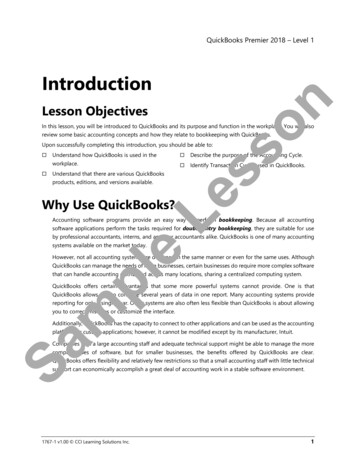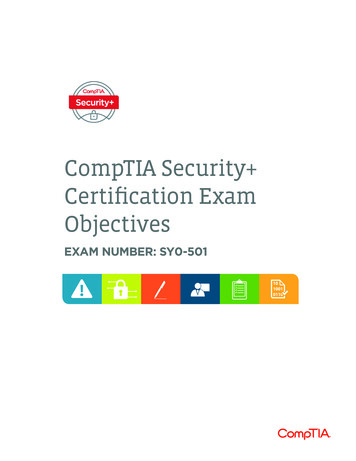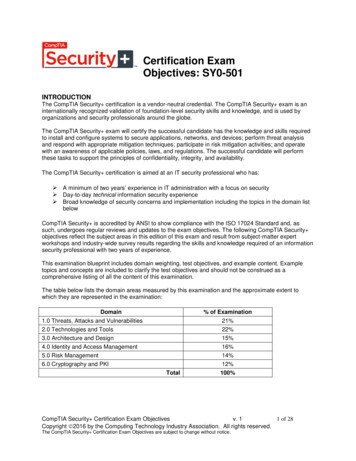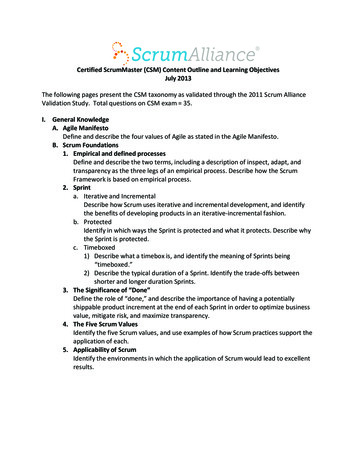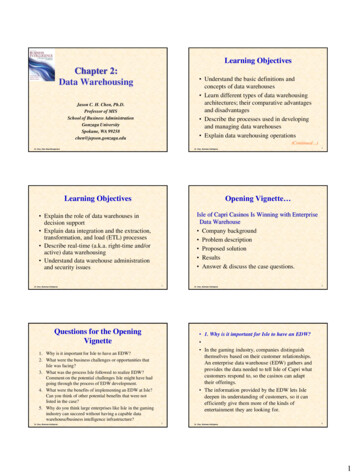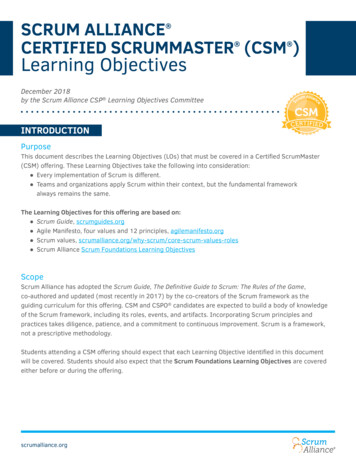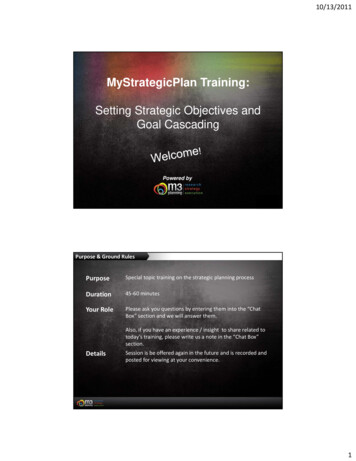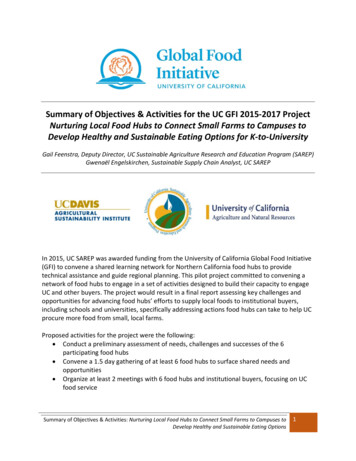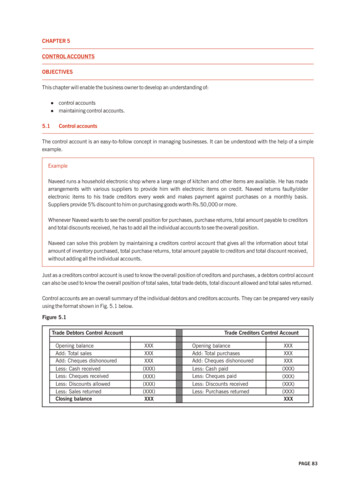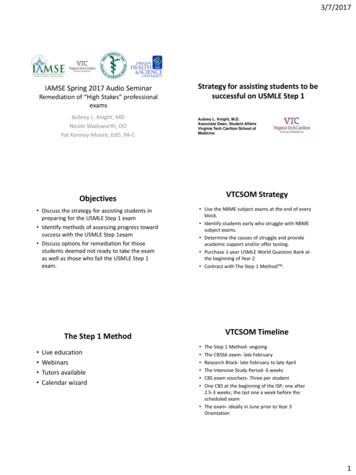
Transcription
3/7/2017IAMSE Spring 2017 Audio SeminarRemediation of “High Stakes” professionalexamsAubrey L. Knight, MDNicole Wadsworth, DOPat Kenney-Moore, EdD, PA-CStrategy for assisting students to besuccessful on USMLE Step 1Aubrey L. Knight, M.D.Associate Dean, Student AffairsVirginia Tech Carilion School ofMedicineVTCSOM StrategyObjectives Discuss the strategy for assisting students inpreparing for the USMLE Step 1 exam Identify methods of assessing progress towardsuccess with the USMLE Step 1exam Discuss options for remediation for thosestudents deemed not ready to take the examas well as those who fail the USMLE Step 1exam. Use the NBME subject exams at the end of everyblock. Identify students early who struggle with NBMEsubject exams. Determine the causes of struggle and provideacademic support and/or offer testing. Purchase 1-year USMLE World Question Bank atthe beginning of Year 2 Contract with The Step 1 MethodTM.VTCSOM TimelineThe Step 1 Method Live educationWebinarsTutors availableCalendar wizard The Step 1 Method- ongoingThe CBSSA exam- late FebruaryResearch Block- late February to late AprilThe Intensive Study Period- 6 weeksCBS exam vouchers- Three per studentOne CBS at the beginning of the ISP; one after2.5-3 weeks; the last one a week before thescheduled exam The exam- ideally in June prior to Year 3Orientation1
3/7/2017NBME CBS Self Assessment Vouchers We purchase 3 per student Purchase the exam with expanded feedback The score and feedback come to the studentimmediately. The score is also available to me because wepurchased the vouchers. We require a score of 202 on a practice exam inorder that the student be allowed to take theexam.VTCSOM CBSSA history Δ from 1st CBSSA score to Step 1- 40.00485 SD- 14.46897 Range- 3-732
3/7/2017What if not making progress duringthe ISP? Face-to-face meetings with the Director of AcademicCounseling and Enrichment Services and AssociateDean of Student Affairs. Private tutoring through The Step 1 Method. Modify the ISP timeline and plan.What if no practice test 202? The student would need to extend the ISP The 1st 4 weeks of Year 3 can be used as a studyelective (VTCSOM has 4 weeks of electives built intothe Year 3 schedule). At the conclusion of this additional 4 weeks, thestudent must take the exam (regardless of the CBSscores).Our history of Step 1 studymodifications Class of 2014- one took a 2 week study elective and threetook a 4 week study elective. All four passed. Class of 2015- two took a 4-week study elective. Both passed. Class of 2016- three took a 4-week study elective. One passedStep 1. One failed Step 1 and the other followed the electivewith a LOA and subsequently withdrew from school withoutever having taken the exam. Class of 2017- one took a 4-week study elective and passedthe exam. Class of 2018- three took a 4-week study elective. All threepassed.What about the student who fails Step 1? May complete the Clerkship/rotation they are on when thescore arrives. If already used 4 weeks of elective for study, must decide ifthey are going to do a quick turnaround and retake the examor take a Leave of Absence from school in order to assess andaddress the issues. If did not use the 4 weeks of elective, immediately aftercompletion of the current clerkship/rotation, takes a 4 weekstudy elective and retakes the exam.Students who take study electives In each case, the student must have face-to-facemeetings with:– The Director of Academic Counseling and EnrichmentServices– Associate Dean of Student Affairs. The student must purchase individual tutoringthrough The Step 1 Method.3
3/7/2017Our history of Step 1 failures Class of 2014- none Class of 2015- one. He decided to take a LOA,pursued an MPH and took and passed Step 1 duringthe MPH. Class of 2016- two. Both withdrew from school. Oneimmediately and one after a six-month LOA. Class of 2017- one. Retook and passed the examafter a 4-week study elective Class of 2018- noneObjectives Discuss our process to assist students inpreparation for COMLEX Level 1 Describe metrics utilized to determine“readiness” Discuss lessons learned over past five yearsEarly Intervention Learning services Curriculum Director Monitoring of all exam performanceAssisting students in preparationfor COMLEX Level 1Nicole Wadsworth, DOAssociate Dean Academic AffairsOhio University Heritage College ofOsteopathic MedicineProcess Early intervention Review of all exam performance over yearsone and two COMSAE exam performance Retention TeamExam Performance 72.5% pass rate on all exams Student performance greater than 1SD belowthe mean consistently over time Block exams more predictive of boarddifficulty– Musculoskeletal– CV– Neurology– Endocrine and Metabolism4
3/7/2017COMSAE examRetention Team Practice style COMLEX exam All students take in March of year two Poor performance triggers additionalintervention Continued poor performance will result indelay of year three clerkships Student Affairs– Director– Learning services Academic Affairs– Curriculum Directors– Assessment staffLessons LearnedClass Pass Rates Struggling students need to focus on boardexam Resource intense Delays in starting clerkship have significantimpact Development of Directed Studies course 2014 – 93.2%2015 – 96.9%2016 – 90.6%2017 – 96.4%2018 – 97.0%Objectives Briefly describe the PA profession and discuss the processof PA education Describe initial and ongoing certification for licensureIAMSE Webinar SeriesRemediation in Health ScienceEducationThe Physician Assistant Perspective Identify accreditation standards for formative andsummative assessments of students Describe options for potential remediation at theformative stage Discuss options for students unable to completesummative assessments successfully Identify methods for dealing with PANCE failuresPat Kenney-Moore EdD, PA-C, Associate Professor SOM Division of Physician Assistant Education305
3/7/2017Overview of the PA Profession PA EducationThe American Academy of Physician Assistants has defined PAs as: medicalproviders who are nationally certified and state licensed to practice medicine. PAsPA educational programs are situated in Academic Health Centers andcan obtain medical histories, conduct physical exams, diagnose and treatuniversities with health systems affiliationsillnesses, order and interpret tests, perform medical procedures like jointinjections, counsel patients on preventive healthcare, assist in surgery, write– Bachelor’s degree and premedical course prerequisites are requiredprescriptions, and make rounds in nursing homes and hospitals, among many– Most programs require direct patient care experience before entranceother medical services.After matriculation, a year is spent in didactic coursework that includes the basic sciences, behavioral sciences and clinical medicinePAs diagnose, treat and prescribe medicine. Thanks to an education created byphysicians and modeled on the medical school curriculum, PAs are certified asmedical generalists with a foundation in primary care. Over the course of theirFollowing the academic/didactic year, students complete more thancareers, many PAs practice in two or three specialty areas, giving them deepexperience and the flexibility to meet the changing needs of their patients,2,000 hours of clinical rotations (analogous to clerkships) in:employers and communities. – Family Medicine / General Internal Medicine– Women’s Health - OBGYN / Pediatrics / General SurgeryTeam-based care is at the core of a PA’s training. PAs can practice autonomouslyor in a collaborative relationship with other members of a patient’s healthcareteam. This combination is a major source of their strength.31– Emergency Medicine / Mental Health – Psychiatry / Electives32CertificationPA Education Graduates of accredited PA programs must pass a nationalcertifying examination (PANCE) administered through theThe PA educational process is anecdotallydescribed as consisting of:National Commission on the Certification of PAs (NCCPA) tobe able to call themselves “Physician Assistant-Certified” or“PA-C.”“Seventy-five percent of medical school in fiftypercent of the time” in order to prepare PAsto perform approximately 80% of medicalservices that are traditionally performed byphysicians. (Ballweg , Sullivan, Brown & Vetrosky, 2008) To maintain this certification, PAs must complete 100 hours ofcontinuing medical education (CME) every 2 years, andsuccessfully complete a comprehensive general medicinerecertification examination every 10 years. Once certified, PAs obtain licensure to practice medicinethrough each state’s regulatory agency, typically a Board of3433Medicine.Certification Outcomes - What is the Scope of the issue?Total Number Of PAs Who Passed PANCE in 2016: 8,025PANCENumber ofExams*PercentPassingNumber ofFirst TimeTakers**Percent ofFirst TimeTakers ,33593%*Represents total number of exams, not number of examinees** Represents total number of first time examineesTotal Number of Certified PAs as of 12/31/2016: 115,547nccpa.net – accessed 2/13/2017Unlike the USMLE Step 1 & 2, thenational PA certifying examinationoccurs AFTER graduation rather thanduring the educational processThe approach to addressing academicconcerns must occur while theindividual is still a matriculant ratherthan after they graduate and sit for theexam356
3/7/2017Accreditation StandardsC3Remediation Based on Formative AssessmentsLow(er) stakes with the potential for remediation within the context of a course or blockto include retesting over the same material, completing additional exercises or otheractivities to demonstrate competence / assimilation of material.STUDENT EVALUATIONC3.01 The program must conduct frequent, objective and documentedevaluations of students related to learning outcomes for both didactic andsupervised clinical education components.C3.03 The program must monitor and document the progress of eachstudent in a manner that promptly identifies deficiencies in knowledge orskills and establishes means for remediation. – We believe that remediation is not achieved through retesting over the same exam content– Scores below 80% trigger a formal remediation process where students review exam contentthat was missed, look up the correct answers and explain why their answers were wrong – Students whose scores are significantly below the national mean are identified as being at riskfor PANCE failure3837Remediation Based on Summative Assessmentsrequirement to repeat all or part of the program.)–However our responsibility is to support the student while they are still students and to assure readiness tograduateA summative OSCE and a summative written examination are administered beforegraduation Dealing with PANCE FailuresBy definition, summative assessments are final and not remediable, and have the potentialto stop a student from progressing through the curriculum (i.e. resulting in dismissal or In the past, NCCPA testing included clinical skills similar to the Step 2 examination–This is very challenging for programs as these individuals are no longer studentsand therefore no longer qualify (technically) for student support services - plusthere is no offset for faculty time spent with graduates Many programs provide some individualized coaching based on PANCE examreports that break down content by “task” (basic science, H&P, most likelydiagnosis, diagnostic testing, management,) and “organ system” (cardiology,pulmonology, gastroenterology etc.)– Practice exams at the program level and from NCCPAThis has been dropped due to issues related to reliability. Responsibility for assessing these skills has been– Recommendations for independent evaluation for accomodationsimbedded into PA accreditation standards such that each program is responsible for assuring competency of basic– Recommendations for external board review coursesclinical skills, and usually takes the form of an experiential OSCE Students who fail components of the summative assessments are counseled on weaknessesand may be referred for student support services / student access & disability services or Because there is such a high passing rate for first-time takers, this generallyaffects small numbers of graduates each year– There is no universally accepted approach to dealing with graduates who have failed the PANCEexam, but most programs take student performance very seriously and feel an obligation to assistcounseling Since the PANCE is founded on medical knowledge based on textbook understandingof basic and clinical sciences, remediation of the core didactic and clinical examinationsis the primary focus in preparing students for PANCE– At the end of the academic phase and the clinical phase all students take a “PACKRAT”examination and individual results are compared with national meansC3.04 The program must conduct and document a summative evaluationof each student within the final four months of the program to verify thateach student is prepared to enter clinical practice. The OHSU PA program requires students to achieve a minimum of 80% on all clinicalmedicine content in order to maintain academic standingThere may be assignment of additional requirements based identified weaknesses–– Most retesters go on to passi.e. DXR cases / MedU cases / Self study with progress examinations 39 A “board review” course is imbedded into the curriculum prior to graduation40Thank you!What Questions CanWe Answer?7
success with the USMLE Step 1exam Discuss options for remediation for those students deemed not ready to take the exam as well as those who fail the USMLE Step 1 exam. VTCSOM Strategy Use the NBME subject exams at the end of every block. Identify students early who struggle with NBME subject exams. Determine the causes of struggle and provide academic support and/or offer testing.
